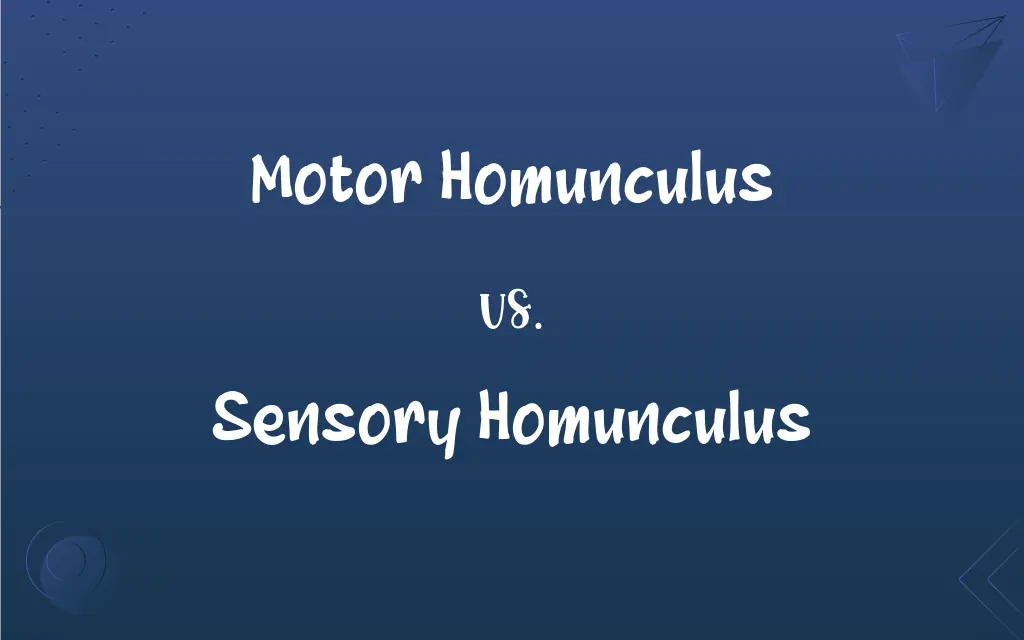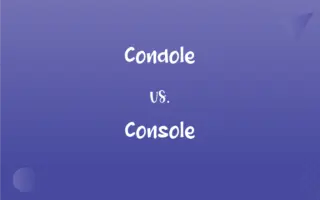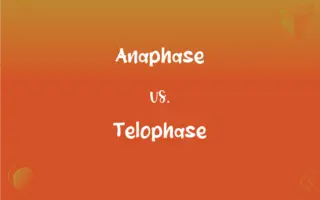Motor Homunculus vs. Sensory Homunculus: What's the Difference?
Edited by Aimie Carlson || By Janet White || Published on March 6, 2024
Motor homunculus represents the brain's motor cortex organization, mapping body parts to motor control, while sensory homunculus maps body parts to sensory perceptions in the brain's sensory cortex.

Key Differences
The motor homunculus is a visual representation of the body's motor control mapped in the brain's motor cortex. It illustrates how various body parts are controlled by different regions of the motor cortex. The sensory homunculus, conversely, represents the sensory processing areas of the brain's sensory cortex, showing how body parts correlate to sensory data processing.
In the motor homunculus, body parts that require precise motor skills, like the hands and face, are disproportionately large due to the extensive brain area dedicated to their control. The sensory homunculus shows a similar disproportionate representation, with areas like the lips and hands being larger due to their higher sensory receptor density.
The motor homunculus is essential for understanding how the brain controls muscle movements and coordination. It highlights areas of the brain responsible for voluntary muscle movements. The sensory homunculus, in contrast, is crucial for understanding how we perceive touch and other sensations, as it maps the brain areas that correspond to sensory inputs from different body parts.
The layout of the motor homunculus can change over time, influenced by learning and experience, a phenomenon known as neuroplasticity. This adaptability is mirrored in the sensory homunculus, which can also reorganize itself in response to changes in sensory input or after injury.
Both the motor and sensory homunculi are distorted representations of the human body, based on the neurological "real estate" each body part occupies in the brain. They are tools for understanding the brain's organization and how different body parts are represented and processed in the motor and sensory cortices.
ADVERTISEMENT
Comparison Chart
Function
Maps motor control in the brain
Maps sensory perceptions in the brain
Cortex Representation
Motor Cortex
Sensory Cortex
Body Part Proportions
Based on control complexity
Based on sensory receptor density
Usage
Understanding muscle movement control
Understanding sensation perception
Adaptability
Changes with learning and experience
Changes with sensory experience or injury
ADVERTISEMENT
Motor Homunculus and Sensory Homunculus Definitions
Motor Homunculus
A map of the motor cortex correlating to control of various body parts.
Surgeons use the motor homunculus to avoid damaging critical motor areas during brain surgery.
Sensory Homunculus
A map showing the correlation between body parts and sensory processing in the brain.
Neuroscientists use the sensory homunculus to understand how touch is processed in the brain.
Motor Homunculus
A distorted figure showing the brain's allocation of motor control to the body.
In the motor homunculus, the lips and tongue occupy a large area due to their fine motor skills.
Sensory Homunculus
An anatomical chart showing how sensory information from the body is mapped in the brain.
The sensory homunculus is key in understanding phantom limb sensations.
Motor Homunculus
A visual guide to how different body parts are controlled by the brain's motor cortex.
The motor homunculus helps explain why finger movements require so much brain power.
Sensory Homunculus
A representation of how the brain's sensory cortex is organized in relation to the body.
The sensory homunculus illustrates why we have heightened sensitivity in our fingers.
Motor Homunculus
A representation of the motor control areas for different body parts in the brain.
The motor homunculus shows larger areas for hands, reflecting their complex movements.
Sensory Homunculus
A distorted figure depicting the sensory perception areas for different body parts.
The large hands on the sensory homunculus show the high concentration of sensory receptors.
Motor Homunculus
An anatomical illustration depicting the motor cortex's role in body movement.
Physical therapists consider the motor homunculus when designing rehabilitation exercises.
Sensory Homunculus
A visual guide illustrating the brain's sensory cortex organization.
The sensory homunculus helps in studying how sensory loss affects brain organization.
FAQs
Can the motor homunculus change?
Yes, it can change with learning and physical experience due to neuroplasticity.
Why are some parts larger in the sensory homunculus?
Larger areas represent body parts with a higher density of sensory receptors.
What does the motor homunculus illustrate?
It illustrates the brain's allocation of motor control to various body parts.
What is the practical use of the sensory homunculus?
It is used to understand sensory processing disorders and in rehabilitation.
Are the representations in the homunculi accurate?
They are exaggerated to emphasize areas with more complex functions or higher sensory input.
What is a motor homunculus?
A motor homunculus is a representation of the motor control areas of different body parts in the brain's motor cortex.
How are the motor and sensory homunculi used in medicine?
They are used in neurology and surgery to understand and protect brain functions during interventions.
Why are some parts larger in the motor homunculus?
Larger areas represent body parts requiring more complex and precise motor control.
What is the sensory homunculus?
The sensory homunculus is a representation of sensory perception areas for different body parts in the brain's sensory cortex.
Why is understanding the motor homunculus important in stroke recovery?
It helps in rehabilitation focused on regaining motor control.
Can learning a new skill change the motor homunculus?
Yes, acquiring new motor skills can lead to changes in the motor homunculus.
What does the sensory homunculus show?
It shows how the brain processes sensory information from various body parts.
Can the motor homunculus be seen in brain imaging?
Yes, brain imaging techniques can visualize the motor homunculus.
Can sensory homunculus mapping help in phantom limb pain?
Yes, it can help understand and treat phantom limb sensations.
Do motor and sensory homunculi appear in the same brain areas?
No, they are located in different but adjacent areas of the cerebral cortex.
Is the sensory homunculus fixed?
No, it can change in response to altered sensory experiences or injuries.
How do the motor and sensory homunculi differ in representation?
The motor homunculus focuses on movement control, while the sensory homunculus on sensation processing.
What happens to the motor homunculus in paralysis?
The affected areas may show reduced activity or change due to neuroplasticity.
How does the sensory homunculus relate to tactile sensitivity?
It explains why some body parts are more sensitive to touch.
Does the sensory homunculus remain constant throughout life?
No, it can change with sensory experiences and aging.
About Author
Written by
Janet WhiteJanet White has been an esteemed writer and blogger for Difference Wiki. Holding a Master's degree in Science and Medical Journalism from the prestigious Boston University, she has consistently demonstrated her expertise and passion for her field. When she's not immersed in her work, Janet relishes her time exercising, delving into a good book, and cherishing moments with friends and family.
Edited by
Aimie CarlsonAimie Carlson, holding a master's degree in English literature, is a fervent English language enthusiast. She lends her writing talents to Difference Wiki, a prominent website that specializes in comparisons, offering readers insightful analyses that both captivate and inform.
































































